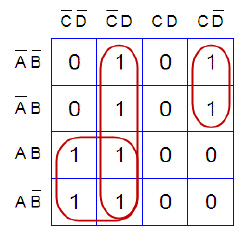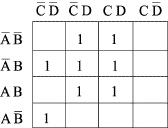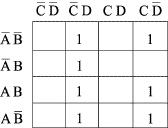True/False
Indicate whether the
statement is true or false.
|
|
|
1.
|
The “X” in a truth table represents a “don’t
care”
|
|
|
2.
|
A “don’t care’ can be used as a 1 to simplify a K-Map
expression.
|
|
|
3.
|
The number of cells in a K-map (Karnaugh map) is always a power of 2, usually 4,
8, or 16.
|
Multiple Choice
Identify the
choice that best completes the statement or answers the question.
|
|
|
4.
|
Write the simplified sum-of-products (SOP) logic expression for the K-Map shown
below: 
|
|
|
5.
|
Write the simplified sum-of-products (SOP) logic expression for the K-Map shown
below:
|
|
|
6.
|
Write the simplified sum-of-products (SOP) logic expression for the K-Map shown
below:
|
|
|
7.
|
Which Boolean equation results
from this Karnaugh map?

|
|
|
8.
|
Which Boolean equation results
from this Karnaugh map?

a. | (  ) +
( ) +
( C) + (BC) C) + (BC) | c. | (AB) + ( C) C) | b. | (ABC) +  | d. | (A ) + C ) + C |
|
|
|
9.
|
Which Boolean equation results
from this Karnaugh map?

|
|
|
10.
|
Which Boolean equation results
from this Karnaugh Map?

|
|
|
11.
|
Which Boolean equation results
from this Karnaugh Map?

|
|
|
12.
|
When ones in a Karnaugh Map are
not next to each other visually, they can be grouped if they are next to each other by means
of
a. | wraparound. | c. | complements. | b. | virtuosity. | d. | technique. |
|
|
|
13.
|
Write the simplified sum-of-products (SOP) logic expression for the K-Map shown
below: a. |  | d. |  | b. |  | e. |  | c. |  | f. | None of these |
|
Multiple Response
Identify one
or more choices that best complete the statement or answer the question.
|
|
|
14.
|
Write the simplified sum-of-products (SOP) logic expression for the K-Map shown
below: Two answers are correct
|